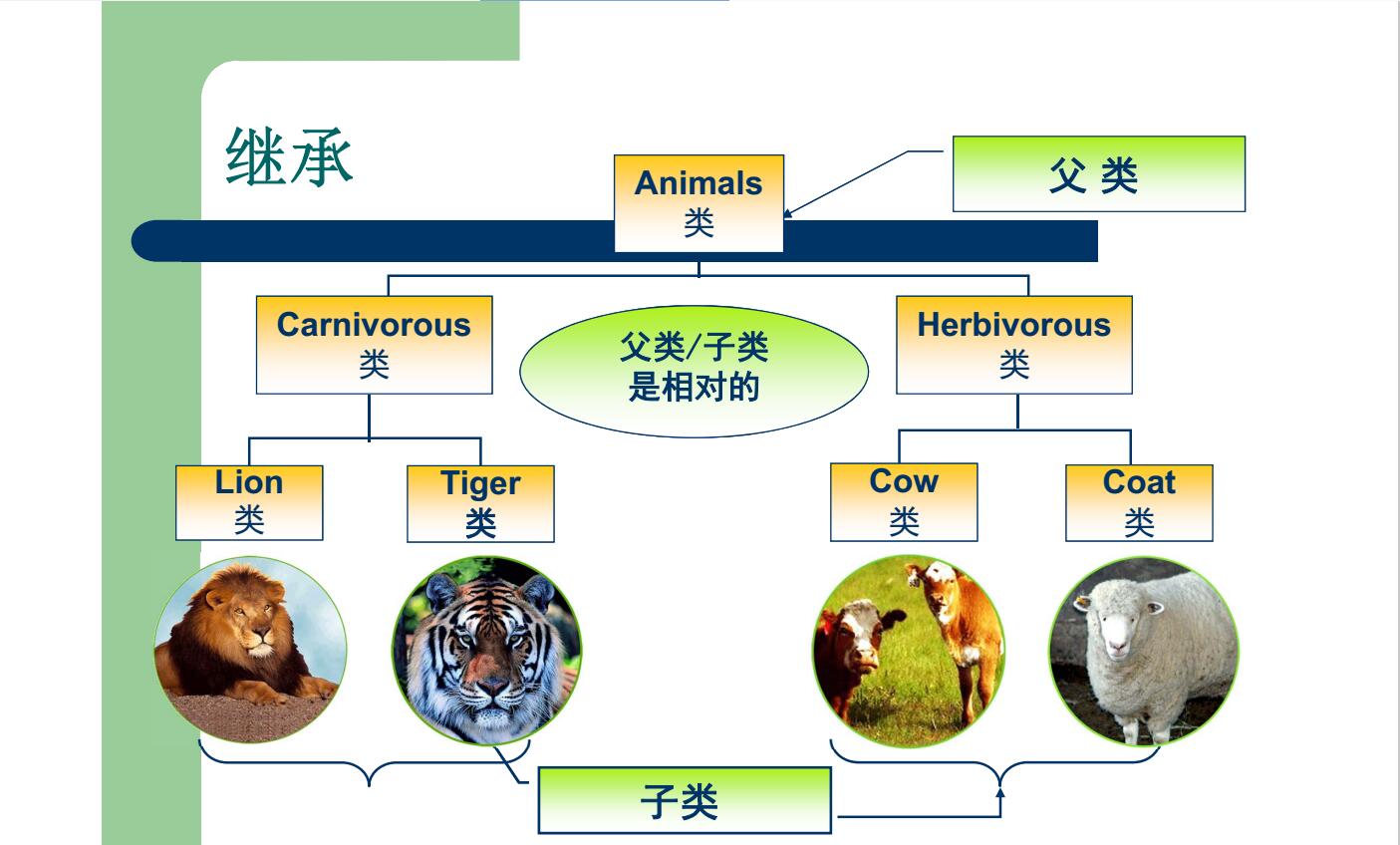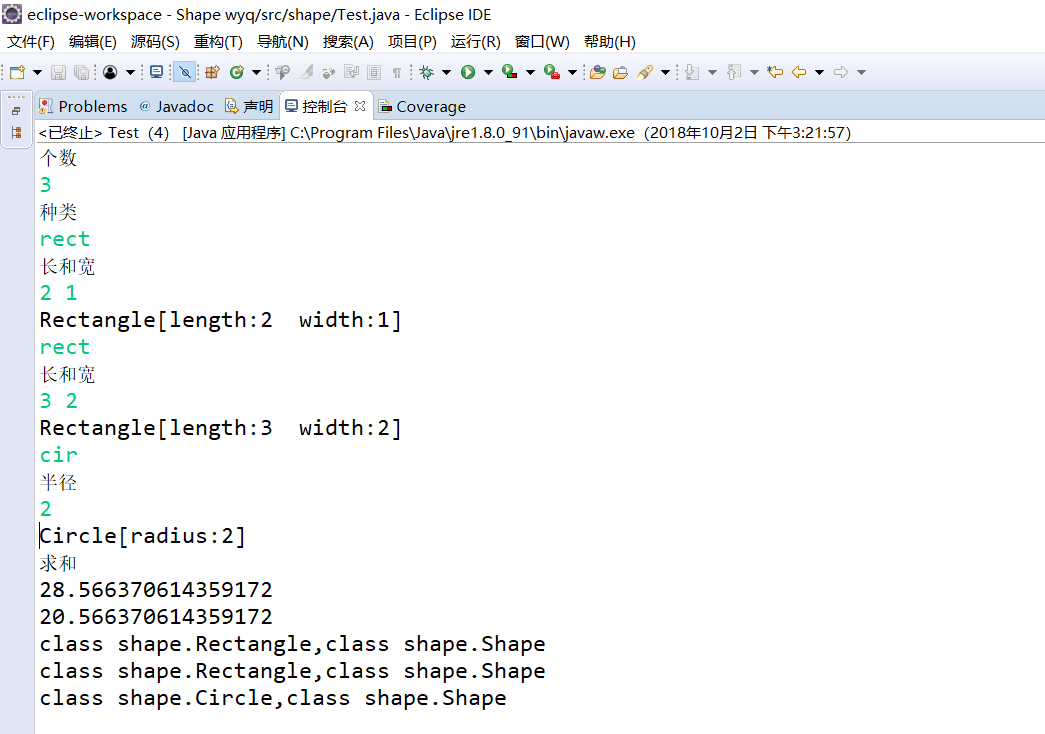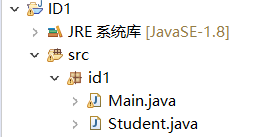王颖奇 201771010129《面向对象程序设计(java)》第六周学习总结
实验六 继承定义与使用
实验时间 2018-9-28
1、目的与要求
理论部分:
继承(inheritance):

继承的特点:具有结构层次;子类继承了父类的域和方法。
主要内容:
(1)类、子类、超类
(2)Object:所有类的超类
(3)泛型数组列表
(4)对象包装器和自动打包
(5)参数数量可变的方法
(6)枚举类
(7)继承设计的技巧******(未学部分)
实验部分:
(1) 理解继承的定义;
(2) 掌握子类的定义要求
(3) 掌握多态性的概念及用法;
(4) 掌握抽象类的定义及用途;
(5) 掌握类中4个成员访问权限修饰符的用途;
(6) 掌握抽象类的定义方法及用途;
(7)掌握Object类的用途及常用API;
(8) 掌握ArrayList类的定义方法及用法;
(9) 掌握枚举类定义方法及用途。
2、实验内容和步骤
实验1: 导入第5章示例程序,测试并进行代码注释。
测试程序1:
Ÿ 在elipse IDE中编辑、调试、运行程序5-1 (教材152页-153页) ;
Ÿ 掌握子类的定义及用法;
Ÿ 结合程序运行结果,理解并总结OO风格程序构造特点,理解Employee和Manager类的关系子类的用途,并在代码中添加注释。
ManagerTest:
package inheritance; /**
* This program demonstrates inheritance.
* @version 1.21 2004-02-21
* @author Cay Horstmann
*/
public class ManagerTest
{
public static void main(String[] args)
{
// 构建管理器对象
Manager boss = new Manager("Carl Cracker", , , , );
boss.setBonus(); Employee[] staff = new Employee[]; // 用Manager和Employee对象填充staff数组 staff[] = boss;
staff[] = new Employee("Harry Hacker", , , , );
staff[] = new Employee("Tommy Tester", , , , ); // 打印所有Employee对象的信息
for (Employee e : staff)
System.out.println("name=" + e.getName() + ",salary=" + e.getSalary());
}
}
Manager:
package inheritance; public class Manager extends Employee
{
private double bonus; /**
* @param name the employee's name
* @param salary the salary
* @param year the hire year
* @param month the hire month
* @param day the hire day
*/
public Manager(String name, double salary, int year, int month, int day)
{
super(name, salary, year, month, day);
bonus = ;
} public double getSalary()
{
double baseSalary = super.getSalary();
return baseSalary + bonus;
} public void setBonus(double b)
{
bonus = b;
}
}
Emloyee:
package inheritance; import java.time.*; public class Employee
{
private String name;
private double salary;
private LocalDate hireDay; public Employee(String name, double salary, int year, int month, int day)
{
this.name = name;
this.salary = salary;
hireDay = LocalDate.of(year, month, day);
} public String getName()
{
return name;
} public double getSalary()
{
return salary;
} public LocalDate getHireDay()
{
return hireDay;
} public void raiseSalary(double byPercent)
{
double raise = salary * byPercent / ;
salary += raise;
}
}
测试结果:

测试程序2:
Ÿ 编辑、编译、调试运行教材PersonTest程序(教材163页-165页);
Ÿ 掌握超类的定义及其使用要求;
Ÿ 掌握利用超类扩展子类的要求;
Ÿ 在程序中相关代码处添加新知识的注释。
PersonTest:
package abstractClasses; /**
* This program demonstrates abstract classes.
* @version 1.01 2004-02-21
* @author Cay Horstmann
*/
public class PersonTest
{
public static void main(String[] args)
{
Person[] people = new Person[]; // 用Student和Employee对象填充人员数组
people[] = new Employee("Harry Hacker", , , , );
people[] = new Student("Maria Morris", "computer science"); // 打印所有Person对象的名称和描述
for (Person p : people)
System.out.println(p.getName() + ", " + p.getDescription());
}
}
Person:
package abstractClasses; public abstract class Person//定义抽象类型Person
{
public abstract String getDescription();//定义抽象描述
private String name; public Person(String name)
{
this.name = name;
} public String getName()
{
return name;
}
}
Employee:
package abstractClasses; import java.time.*; public class Employee extends Person//子类Employee继承父类Person
{
private double salary;
private LocalDate hireDay; public Employee(String name, double salary, int year, int month, int day)
{
super(name);//继承父类的方法
this.salary = salary;
hireDay = LocalDate.of(year, month, day);//hireDay使用LocalDate的方法
} public double getSalary()
{
return salary;
} public LocalDate getHireDay()
{
return hireDay;
} public String getDescription()
{
return String.format("an employee with a salary of $%.2f", salary);
} public void raiseSalary(double byPercent)
{
double raise = salary * byPercent / ;
salary += raise;
}
}
Student:
package abstractClasses; public class Student extends Person//子类Student继承父类Person
{
private String major; /**
* @param nama the student's name
* @param major the student's major
*/
public Student(String name, String major)
{
// 将name传递给父类构造函数
super(name);
this.major = major;
} public String getDescription()
{
return "a student majoring in " + major;
}
}
测试结果:

测试程序3:
Ÿ 编辑、编译、调试运行教材程序5-8、5-9、5-10,结合程序运行结果理解程序(教材174页-177页);
Ÿ 掌握Object类的定义及用法;
Ÿ 在程序中相关代码处添加新知识的注释。
EqualsTest:
package equals; /**
* This program demonstrates the equals method.
* @version 1.12 2012-01-26
* @author Cay Horstmann
*/
public class EqualsTest
{
public static void main(String[] args)
{
Employee alice1 = new Employee("Alice Adams", , , , );
Employee alice2 = alice1;
Employee alice3 = new Employee("Alice Adams", , , , );
Employee bob = new Employee("Bob Brandson", , , , ); System.out.println("alice1 == alice2: " + (alice1 == alice2)); System.out.println("alice1 == alice3: " + (alice1 == alice3)); System.out.println("alice1.equals(alice3): " + alice1.equals(alice3)); System.out.println("alice1.equals(bob): " + alice1.equals(bob)); System.out.println("bob.toString(): " + bob); Manager carl = new Manager("Carl Cracker", , , , );
Manager boss = new Manager("Carl Cracker", , , , );
boss.setBonus();
System.out.println("boss.toString(): " + boss);
System.out.println("carl.equals(boss): " + carl.equals(boss));
System.out.println("alice1.hashCode(): " + alice1.hashCode());
System.out.println("alice3.hashCode(): " + alice3.hashCode());
System.out.println("bob.hashCode(): " + bob.hashCode());
System.out.println("carl.hashCode(): " + carl.hashCode());
}
}
Employee:
package equals; import java.time.*;
import java.util.Objects; public class Employee
{
private String name;
private double salary;
private LocalDate hireDay; public Employee(String name, double salary, int year, int month, int day)
{
this.name = name;
this.salary = salary;
hireDay = LocalDate.of(year, month, day);
} public String getName()
{
return name;
} public double getSalary()
{
return salary;
} public LocalDate getHireDay()
{
return hireDay;
} public void raiseSalary(double byPercent)
{
double raise = salary * byPercent / ;
salary += raise;
} public boolean equals(Object otherObject)
{
// 快速测试,看看这些对象是否相同
if (this == otherObject) return true; // 如果显式参数为空,则必须返回false
if (otherObject == null) return false; // 如果类不匹配,它们就不能相等
if (getClass() != otherObject.getClass()) return false; // 现在我们知道otherObject是一个非空雇员
Employee other = (Employee) otherObject; // 测试字段是否具有相同的值
return Objects.equals(name, other.name) && salary == other.salary && Objects.equals(hireDay, other.hireDay);
} public int hashCode()
{
return Objects.hash(name, salary, hireDay);
} public String toString()
{
return getClass().getName() + "[name=" + name + ",salary=" + salary + ",hireDay=" + hireDay
+ "]";
}
}
Manager:
package equals; public class Manager extends Employee//子类Manager继承父类Employee
{
private double bonus; public Manager(String name, double salary, int year, int month, int day)
{
super(name, salary, year, month, day);
bonus = ;
} public double getSalary()
{
double baseSalary = super.getSalary();
return baseSalary + bonus;
} public void setBonus(double bonus)
{
this.bonus = bonus;
} public boolean equals(Object otherObject)
{
if (!super.equals(otherObject)) return false;
Manager other = (Manager) otherObject;
// super.equals检查这个和其他属于同一个类
return bonus == other.bonus;
} public int hashCode()
{
return java.util.Objects.hash(super.hashCode(), bonus);
} public String toString()
{
return super.toString() + "[bonus=" + bonus + "]";
}
}
测试结果:

测试程序4:
Ÿ 在elipse IDE中调试运行程序5-11(教材182页),结合程序运行结果理解程序;
Ÿ 掌握ArrayList类的定义及用法;
Ÿ 在程序中相关代码处添加新知识的注释。
ArrayListTest:
package arrayList; import java.util.*; /**
* This program demonstrates the ArrayList class.
* @version 1.11 2012-01-26
* @author Cay Horstmann
*/
public class ArrayListTest
{
public static void main(String[] args)
{
// 用三个Employee对象填充staff数组列表
ArrayList<Employee> staff = new ArrayList<>(); staff.add(new Employee("Carl Cracker", , , , ));
staff.add(new Employee("Harry Hacker", , , , ));
staff.add(new Employee("Tony Tester", , , , )); // 把每个人的薪水提高5%
for (Employee e : staff)
e.raiseSalary(); // 打印所有Employee对象的信息
for (Employee e : staff)
System.out.println("name=" + e.getName() + ",salary=" + e.getSalary() + ",hireDay="
+ e.getHireDay());
}
}
Employee:
package arrayList; import java.time.*; public class Employee
{
private String name;
private double salary;
private LocalDate hireDay; public Employee(String name, double salary, int year, int month, int day)
{
this.name = name;
this.salary = salary;
hireDay = LocalDate.of(year, month, day);
} public String getName()
{
return name;
} public double getSalary()
{
return salary;
} public LocalDate getHireDay()
{
return hireDay;
} public void raiseSalary(double byPercent)
{
double raise = salary * byPercent / ;
salary += raise;
}
}
测试结果:

测试程序5:
Ÿ 编辑、编译、调试运行程序5-12(教材189页),结合运行结果理解程序;
Ÿ 掌握枚举类的定义及用法;
在程序中相关代码处添加新知识的注释。
package enums; import java.util.*; /**
* This program demonstrates enumerated types.
* @version 1.0 2004-05-24
* @author Cay Horstmann
*/
public class EnumTest
{
public static void main(String[] args)
{
Scanner in = new Scanner(System.in);
System.out.print("Enter a size: (SMALL, MEDIUM, LARGE, EXTRA_LARGE) ");
String input = in.next().toUpperCase();
Size size = Enum.valueOf(Size.class, input);
System.out.println("size=" + size);
System.out.println("abbreviation=" + size.getAbbreviation());
if (size == Size.EXTRA_LARGE)//判断语句
System.out.println("Good job--you paid attention to the _.");
}
} enum Size
{
SMALL("S"), MEDIUM("M"), LARGE("L"), EXTRA_LARGE("XL"); private Size(String abbreviation) { this.abbreviation = abbreviation; }
public String getAbbreviation() { return abbreviation; } private String abbreviation;
}
测试结果:


实验2:编程练习1
Ÿ 定义抽象类Shape:
属性:不可变常量double PI,值为3.14;
方法:public double getPerimeter();public double getArea())。
Ÿ 让Rectangle与Circle继承自Shape类。
Ÿ 编写double sumAllArea方法输出形状数组中的面积和和double sumAllPerimeter方法输出形状数组中的周长和。
Ÿ main方法中
1)输入整型值n,然后建立n个不同的形状。如果输入rect,则再输入长和宽。如果输入cir,则再输入半径。
2) 然后输出所有的形状的周长之和,面积之和。并将所有的形状信息以样例的格式输出。
3) 最后输出每个形状的类型与父类型,使用类似shape.getClass()(获得类型),shape.getClass().getSuperclass()(获得父类型);
思考sumAllArea和sumAllPerimeter方法放在哪个类中更合适?
输入样例:
3
rect
1 1
rect
2 2
cir
1
输出样例:
18.28
8.14
[Rectangle [width=1, length=1], Rectangle [width=2, length=2], Circle [radius=1]]
class Rectangle,class Shape
class Rectangle,class Shape
class Circle,class Shape
代码:

Test:
public static void main(String[] args) {
Scanner in = new Scanner(System.in);
System.out.println("个数");
int a = in.nextInt();
System.out.println("种类");
String rect="rect";
String cir="cir";
Shape[] num=new Shape[a];
for(int i=0;i<a;i++){
String input=in.next();
if(input.equals(rect)) {
System.out.println("长和宽");
int length = in.nextInt();
int width = in.nextInt();
num[i]=new Rectangle(width,length);
System.out.println("Rectangle["+"length:"+length+" width:"+width+"]");
}
if(input.equals(cir)) {
System.out.println("半径");
int radius = in.nextInt();
num[i]=new Circle(radius);
System.out.println("Circle["+"radius:"+radius+"]");
}
}
Test c=new Test();
System.out.println("求和");
System.out.println(c.sumAllPerimeter(num));
System.out.println(c.sumAllArea(num));
for(Shape s:num) {
System.out.println(s.getClass()+","+s.getClass().getSuperclass());
}
}
public double sumAllArea(Shape score[])
{
double sum=0;
for(int i=0;i<score.length;i++)
sum+= score[i].getArea();
return sum;
}
{
double sum=0;
for(int i=0;i<score.length;i++)
sum+= score[i].getPerimeter();
return sum;
}
}
shape:
package shape;
abstract class Shape { //定义抽象父类Shape
abstract double getPerimeter(); //定义求解周长的方法
abstract double getArea(); //定义求解面积的方法
}
class Rectangle extends Shape{
private int length;
private int width;
public Rectangle(int length, int width) {
this.length = length;
this.width = width;
}
//继承父类
double getPerimeter(){ //调用父类求周长的方法
return *(length+width);
}
double getArea(){
return length*width; //调用父类求面积的方法
}
}
class Circle extends Shape{
private int radius;
public Circle(int radius) {
this.radius = radius;
}
double getPerimeter(){
return * Math.PI * radius;
}
double getArea(){
return Math.PI * radius * radius;
}
}
测试结果:

实验3: 编程练习2
编制一个程序,将身份证号.txt 中的信息读入到内存中,输入一个身份证号或姓名,查询显示查询对象的姓名、身份证号、年龄、性别和出生地。
代码:

Main:
package id1; import java.io.BufferedReader;
import java.io.File;
import java.io.FileInputStream;
import java.io.FileNotFoundException;
import java.io.IOException;
import java.io.InputStreamReader;
import java.util.ArrayList;
import java.util.Scanner; public class Main{
private static ArrayList<Student> studentlist;
public static void main(String[] args) {
studentlist = new ArrayList<>();
Scanner scanner = new Scanner(System.in);
File file = new File("C:\\Users\\ASUS\\Desktop\\新建文件夹\\身份证号.txt");
try {
FileInputStream fis = new FileInputStream(file);
BufferedReader in = new BufferedReader(new InputStreamReader(fis));
String temp = null;
while ((temp = in.readLine()) != null) { Scanner linescanner = new Scanner(temp); linescanner.useDelimiter(" ");
String name = linescanner.next();
String number = linescanner.next();
String sex = linescanner.next();
String year = linescanner.next();
String province =linescanner.nextLine();
Student student = new Student();
student.setName(name);
student.setnumber(number);
student.setsex(sex);
student.setyear(year);
student.setprovince(province);
studentlist.add(student); }
} catch (FileNotFoundException e) {
System.out.println("学生信息文件找不到");
e.printStackTrace();
} catch (IOException e) {
System.out.println("学生信息文件读取错误");
e.printStackTrace();
}
boolean isTrue = true;
while (isTrue) { System.out.println("1.按姓名查询");
System.out.println("2.按身份证号查询");
System.out.println("3.退出");
int nextInt = scanner.nextInt();
switch (nextInt) {
case :
System.out.println("请输入姓名");
String studentname = scanner.next();
int nameint = findStudentByname(studentname);
if (nameint != -) {
System.out.println("查找信息为:身份证号:"
+ studentlist.get(nameint).getnumber() + " 姓名:"
+ studentlist.get(nameint).getName() +" 性别:"
+studentlist.get(nameint).getsex() +" 年龄:"
+studentlist.get(nameint).getyaer()+" 地址:"
+studentlist.get(nameint).getprovince()
);
} else {
System.out.println("不存在该学生");
}
break;
case :
System.out.println("请输入身份证号");
String studentid = scanner.next();
int idint = findStudentByid(studentid);
if (idint != -) {
System.out.println("查找信息为:身份证号:"
+ studentlist.get(idint ).getnumber() + " 姓名:"
+ studentlist.get(idint ).getName() +" 性别:"
+studentlist.get(idint ).getsex() +" 年龄:"
+studentlist.get(idint ).getyaer()+" 地址:"
+studentlist.get(idint ).getprovince()
);
} else {
System.out.println("不存在该学生");
}
break;
case :
isTrue = false;
System.out.println("程序已退出!");
break;
default:
System.out.println("输入有误");
}
}
} public static int findStudentByname(String name) {
int flag = -;
int a[];
for (int i = ; i < studentlist.size(); i++) {
if (studentlist.get(i).getName().equals(name)) {
flag= i;
}
}
return flag;
} public static int findStudentByid(String id) {
int flag = -; for (int i = ; i < studentlist.size(); i++) {
if (studentlist.get(i).getnumber().equals(id)) {
flag = i;
}
}
return flag;
}
}
Student:
package id1;
public class Student {
private String name;
private String number ;
private String sex ;
private String year;
private String province;
public String getName() {
return name;
}
public void setName(String name) {
this.name = name;
}
public String getnumber() {
return number;
}
public void setnumber(String number) {
this.number = number;
}
public String getsex() {
return sex ;
}
public void setsex(String sex ) {
this.sex =sex ;
}
public String getyaer() {
return year;
}
public void setyear(String year ) {
this.year=year ;
}
public String getprovince() {
return province;
}
public void setprovince(String province) {
this.province=province ;
}
}
测试结果:

总结:
通过本周的学习,我了解到了什么是继承(新类继承了旧类的方法和域,并添加了新的方法和域)以及它的特点和优点,并通过老师的讲解和课后的学习,大致明白了什么是类、子类、超类,掌握了父类与子类的部分用法,学会了如何定义抽象类,使用super关键字等。初步的理解了继承的结构层次和多态性的概念。在课下的学习中,通过示例程序以及查阅资料,也学到了很多有用的知识,但仍有很多疑惑,望老师能仔细讲解。

王颖奇 201771010129《面向对象程序设计(java)》第六周学习总结的更多相关文章
- 201771010134杨其菊《面向对象程序设计java》第九周学习总结
第九周学习总结 第一部分:理论知识 异常.断言和调试.日志 1.捕获 ...
- 201871010132-张潇潇《面向对象程序设计(java)》第一周学习总结
面向对象程序设计(Java) 博文正文开头 项目 内容 这个作业属于哪个课程 https://www.cnblogs.com/nwnu-daizh/ 这个作业的要求在哪里 https://www.cn ...
- 扎西平措 201571030332《面向对象程序设计 Java 》第一周学习总结
<面向对象程序设计(java)>第一周学习总结 正文开头: 项目 内容 这个作业属于哪个课程 https://www.cnblogs.com/nwnu-daizh/ 这个作业的要求在哪里 ...
- 杨其菊201771010134《面向对象程序设计Java》第二周学习总结
第三章 Java基本程序设计结构 第一部分:(理论知识部分) 本章主要学习:基本内容:数据类型:变量:运算符:类型转换,字符串,输入输出,控制流程,大数值以及数组. 1.基本概念: 1)标识符:由字母 ...
- 201871010124 王生涛《面向对象程序设计JAVA》第一周学习总结
项目 内容 这个作业属于哪个课程 https://www.cnblogs.com/nwnu-daizh/ 这个作业的要求在哪里 https://edu.cnblogs.com/campus/xbsf/ ...
- 201871010115——马北《面向对象程序设计JAVA》第二周学习总结
项目 内容 这个作业属于哪个课程 https://www.cnblogs.com/nwnu-daizh/ 这个作业的要求在哪里 https://www.cnblogs.com/nwnu-daizh/p ...
- 201777010217-金云馨《面向对象程序设计(Java)》第二周学习总结
项目 内容 这个作业属于哪个课程 https://www.cnblogs.com/nwnu-daizh/ 这个作业的要求在哪里 https://www.cnblogs.com/nwnu-daizh/p ...
- 201871010132——张潇潇《面向对象程序设计JAVA》第二周学习总结
项目 内容 这个作业属于哪个课程 https://www.cnblogs.com/nwnu-daizh/ 这个作业的要求在哪里 https://www.cnblogs.com/nwnu-daizh/p ...
- 201771010123汪慧和《面向对象程序设计Java》第二周学习总结
一.理论知识部分 1.标识符由字母.下划线.美元符号和数字组成, 且第一个符号不能为数字.标识符可用作: 类名.变量名.方法名.数组名.文件名等.第二部分:理论知识学习部分 2.关键字就是Java语言 ...
- 201521123061 《Java程序设计》第六周学习总结
201521123061 <Java程序设计>第六周学习总结 ***代码阅读:Child压缩包内 1. 本周学习总结 1.1 面向对象学习暂告一段落,请使用思维导图,以封装.继承.多态为核 ...
随机推荐
- AJ学IOS(04)UI之半小时搞定Tom猫
AJ分享 必须精品 效果图 曾经风靡一时的tom猫其实制作起来那是叫一个相当的easy啊 功能全部实现,(关键是素材,没有素材的可以加我微信) 新手也可以很快的完成tom这个很拉轰的ios应用哦 然 ...
- MyEclipse 10安装SVN插件subclipse
1. 下载SVN插件subclipse 下载地址:http://subclipse.tigris.org/servlets/ProjectDocumentList?expandFolder=2240& ...
- Three.js实现3D地图实例分享
本文主要给大家介绍了关于利用Three.js开发实现3D地图的实践过程,文中通过示例代码介绍的非常详细,对大家学习或者使用three.js具有一定的参考学习价值,需要的朋友们下面随着小编来一起学习学习 ...
- Android应用架构分析
一.res目录: 1.属性:Android必需: 2.作用:存放Android项目的各种资源文件.这些资源会自动生成R.java. 2.1.layout:存放界面布局文件. 2.2.strings.x ...
- DES原理及代码实现
一.DES基础知识DES技术特点 DES是一种用56位密钥来加密64位数据的方法 DES采取了分组加密算法:明文和密文为64位分组长度 DES采取了对称算法:加密和解密除密钥编排不同外,使 ...
- 百度关键词搜索工具 v1.1|url采集工具 v1.1
功能介绍:关键词搜索工具 批量关键词自动搜索采集 自动去除垃圾二级泛解析域名 可设置是否保存域名或者url 持续更新中
- Laravel 分页 数据丢失问题解决
问题: to do list 中有32条数据,每页10条,共3页. 做完了一个事项之后,准备打卡,发现找不到这个事项. 数据库查询正常,有这一条数据. 原因: 发现是分页出了问题,第1页的数据和第2页 ...
- python 进阶篇 函数装饰器和类装饰器
函数装饰器 简单装饰器 def my_decorator(func): def wrapper(): print('wrapper of decorator') func() return wrapp ...
- Go语言 2019 调查报告发布
Go 官方博客昨日公布了[ 2019 年 Go 语言调查报告].本次调查收到的回复达到 10,975 份,约为去年的两倍. 这些受访者的反馈意见将被选取用于改进 Go 语言的发展. 以下是 2019 ...
- audio的自动播放报错解决
使用audio标签时,当前页面没有进行交互时,比如用户刷新了页面后,play()调用就会报错,如下图 查找资料后,发现是2018年4月以后,chrome浏览器对这块进行了优化,为了节约流量,禁止了自动 ...
